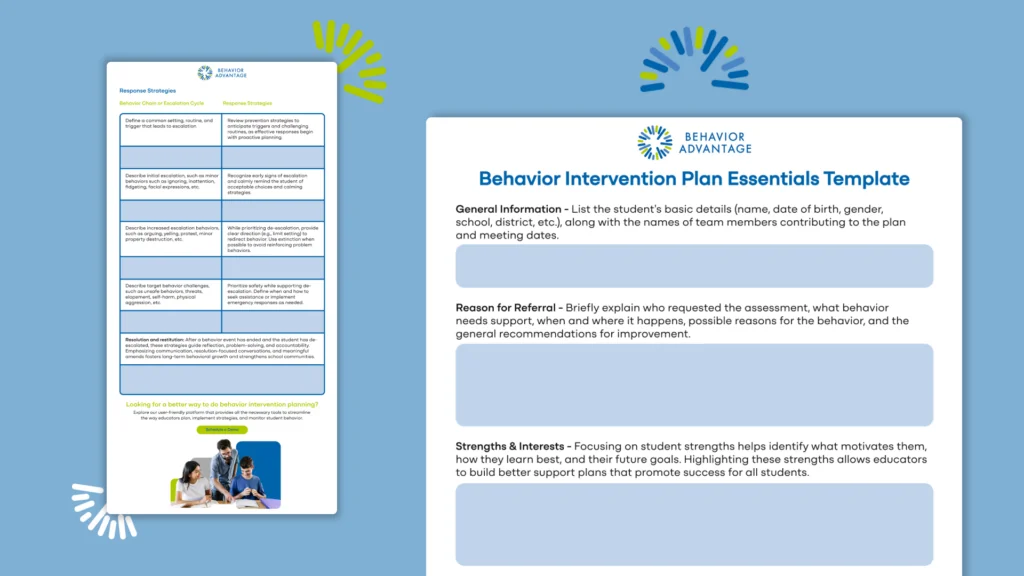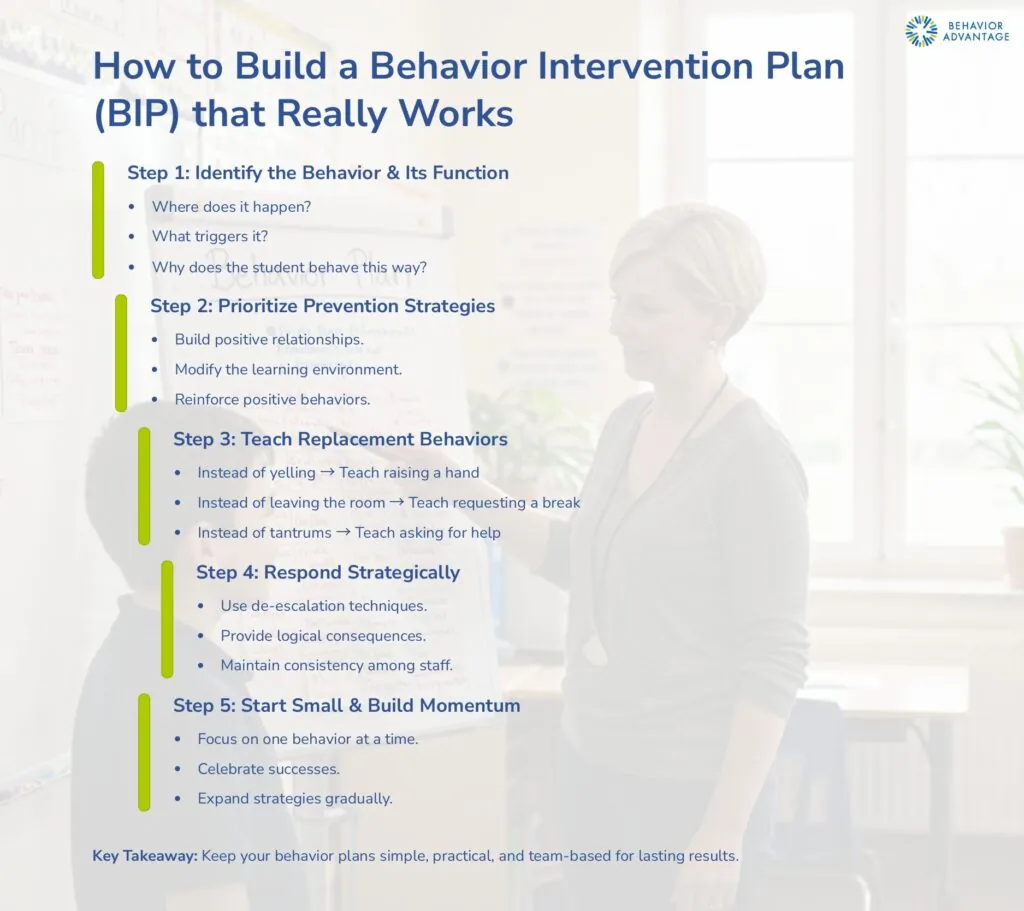A Behavior Intervention Plan (BIP) is a structured plan designed to prevent problem behaviors, teach replacement skills, and provide effective responses when behaviors occur. However, many behavior plans focus too much on discipline and reaction, missing the most critical components of behavior change: prevention and skill-building.
We know there are some recurring problems with BIPs. Guides on how to write a Behavior Intervention Plan can often be too technical, confusing or offer very little practical advice. Therefore, this article will focus on prevention and skill-building and how to use them to set the students up for success. We will also discuss the role of effective response strategies, such as de-escalation, providing logical consequences, and avoiding power struggles. Finally, we will give tips on how to start small and gradually build momentum by targeting one manageable routine and celebrating success.
Benefits of Writing a Behavior Intervention Plan
One key reason BIPs are so useful is the clear academic and social benefits they promote.
Improvement in Student Behavior = Reduction in Classroom Disruptions
Unlike punitive discipline, a BIP does not just react to misbehavior but actively teaches and motivates better behavior.
It is grounded in understanding why a behavior is occurring and then addressing those underlying causes. BIPs typically use a Functional Behavioral Assessment (FBA) to pinpoint triggers and functions of the problem behavior, such as seeking attention, escaping a task, or sensory needs.
As students exhibit fewer disruptive behaviors, the overall number of disruptions — such as outbursts or discipline referrals — tends to decline. This allows them to pay better attention to instruction, participate more in activities, and ultimately make greater academic progress.
Positive Impact on Teacher-Student Relationships
Likewise, BIPs transform the dynamic between teachers and students by emphasizing positive reinforcement and skill-building rather than punishment. When you shift from constant discipline to a more coaching role under a BIP, your students will respond with increased respect and cooperation. Ultimately, strong teacher-student relationships correlate with better behavior and academic outcomes.
Long-Term Effects on Academic Success
Behavior Intervention Plans prevent behavioral issues from disrupting a student’s education. They teach self-management skills that promote long-term academic success. Eventually, most plans aim for students to outgrow them by learning healthy new habits, allowing them to thrive on their own in school and beyond.
Now let’s see how to write a behavior intervention plan.
Download Our Expertly Created Behavior Plan Template to Support Your Writing of BIPs

Creating an effective Behavior Intervention Plan (BIP) starts with understanding why the behavior is happening and how to support meaningful change.
This behavior plan template will guide your team through a function-based, team-driven approach to problem-solving, ensuring that interventions align with student need and are rooted in evidence-based practices.
By focusing on small, strategic behavior changes, this template helps schools build sustainable, proactive supports. Download the BIP Essential Components template to structure your plan with clear, practical steps that foster actual implementation and real progress for students.
Step 1: Begin with the Behavior
Identify the Problem Behavior
Remember that every behavior serves a function—a purpose for the student. It is not random. Use function-based problem-solving to create an effective BIP by asking:
- Where is the problem behavior most likely to occur?
- What contextual variables or triggers set the stage for the behavior?
- Why does the student use these behaviors in these situations?
Define the Behavior and Develop a Hypothesis
To illustrate the point, imagine a student frequently leaving their seat and wandering during writing tasks. When analyzed using function-based problem-solving, the pattern reveals the following picture.
When the teacher gives a long writing assignment during independent seat work, the student gets up and walks around the room despite redirection. This enables the student to avoid writing for several minutes. Therefore, the function of the behavior is most likely to escape or avoid the writing task.
This hypothesis will help the team match specific intervention strategies, define teaching goals in functional terms, and help track improvement.In many cases, a simple team discussion can help identify function and context. However, for more complex or severe behaviors, turn to a more formal FBA.
Step 2: Focus on Prevention Strategies First
A strong Behavior Intervention Plan does not start with discipline—it starts with prevention. If we only react to behavior after it happens, we might be “watering the weeds” instead of stopping the problem at the source.
Ask yourself: How can we make this behavior less likely to happen in the first place?
Build a Positive Relationship
When students feel safe, valued, and connected, they are more likely to engage in appropriate behaviors. Using the 2×10 Strategy or the 5:1 Ratio Strategy can help build positive relationships and repair struggling ones. Modify the Environment
The goal here is to provide support encouraging better choices and to remove unnecessary triggers to problem behaviors.
Reduce task difficulty, provide writing support, or allow alternatives like typing.
Use Positive Reinforcement
Recognizing and reinforcing small successes helps build confidence and motivation. Positive reinforcement throughout daily routines creates a supportive environment where students feel capable and encouraged to succeed.
When designing Behavior Intervention Plans (BIPs), consider practical motivators such as token systems, extra privileges, or specific praise. For example, a student may earn points toward a preferred activity, receive additional classroom responsibilities, or be acknowledged for their effort with encouraging feedback like, “I love how you started your work right away!”
Instead of waiting for a student to become distracted during writing tasks, introduce a visual checklist and scheduled brain breaks every five minutes. Over time, the student builds stamina and can engage in writing for longer periods without wandering.
Interested in learning more about effective prevention strategies? Visit our website to explore real-world classroom applications and best practices.
Step 3: Teach Replacement Behaviors
If a student is using problem behavior to meet a need, we need to teach a more appropriate way to achieve the same goal.
Examples of Replacement Skills:
- Instead of yelling for attention → Teach raising a hand
- Instead of leaving the room → Teach requesting a break
- Instead of throwing a tantrum over work → Teach asking for help
Key Tip: Teach replacement behaviors when the student is calm and regulated—not in the heat of the moment. Practice and reinforce these skills in low-stress situations before expecting them to “work” during real challenges.
Step 4: Incorporate Effective Response Strategies into your Behavior Intervention Plan
Even with the best prevention strategies, problem behaviors will still happen sometimes. The key is to respond in a way that reduces future problems rather than escalating them.
A good response plan includes:
De-escalation Techniques
De-escalation is often a subtle but effective way to manage students. When done well, they hardly realize it is happening. The key is to stay calm, use nonverbal cues, and avoid power struggles.
Logical and Meaningful Consequences
Logical consequences are not reactive outcomes of behavior but are deliberately set by teachers and administrators. They mirror real-life adult consequences, helping students learn skills for future success. Consequences should match the function of behavior (e.g., if a student avoids work, suspension or sending them home could actually reinforce the behavior).
Safety Net Procedures
The BIP should contain a safety plan as a just-in-case component. This outlines emergency strategies to keep everyone safe when serious episodes occur. Hopefully, you will not need it often, but critical for high-risk behaviors.
Look for Consistency
Consistency is key to a successful Behavior Intervention Plan (BIP). When all staff respond the same way, students receive clear, predictable expectations, reducing confusion and reinforcing positive behavior. Inconsistent responses can lead to mixed messages, testing of limits, and slower progress.
A predictable approach builds trust, reduces anxiety, and strengthens behavior change over time. To ensure consistency, all team members should follow the same plan, use common language, and reinforce expectations reliably. When the team is aligned, students experience a structured, supportive environment that promotes lasting success.
Step 5: Start Small, Build Momentum
Many BIPs fail because they try to change too many behaviors at once. Instead, start with one manageable routine and build from there.
3 Key Tips
In this video our CEO Aaron Stabel, BCBA shares his to tips on how to write a Behavior Intrevention Plan and the importance of starting small.
- Choose one behavior in one routine to start (e.g., staying seated during writing tasks, or asking for help when frustrated during math).
- Celebrate small successes to reinforce progress and build momentum
- Gradually expand the plan to include other areas once the student is succeeding.
For example, a student who struggles with transitions is first taught a visual schedule for moving between reading and math. Once successful, the strategy is expanded to other parts of the day. This reduces complexity, improves implementation, increases consistency, and sets everyone up for long-term success.
Key Tip: An effective BIP always monitors progress and applies readjustments. If the data shows progress, those strategies are reinforced and gradually reduced to build student independence. If improvement is minimal or absent, you need to re-examine the plan.
Challenges to Look out for
Schools often face common hurdles that weaken Behavior Intervention Plans (BIPs). When there’s no standard template or teacher training, quality and consistency suffer. Subjective or incomplete data can make it unclear if the student is progressing. Without automated tools to spot behavior trends or a centralized system for sharing information, interventions may remain one-size-fits-all, and team involvement becomes more difficult.
However, you should not let that discourage you, as the benefits of BIPs far outweigh any potential disadvantages.

Make sure to read our other guides on BIPs and IEP: Five Steps to Align Your BIP with IEP Objectives – and Why Replacement Behaviors Matter.
Final Thoughts: Keep Behavior Plans Practical & Team-Based
A Behavior Intervention Plan is only effective if the people implementing it can actually follow through. Overcomplicated plans with too many interventions don’t work—but simple, targeted strategies done well can make a huge impact.
There are three things you should take away from this:
- Keep it simple and realistic.
- Involve the entire team. The benefits of school-wide behavioral interventions that include teachers, support staff, students themselves, and parents are backed by research.
- Use data to track progress. Adjust as needed based on real classroom results.
Need help designing a behavior plan? Learn more about how Behavior Advantage can simplify BIPs for your school.
Our platform guides educators in writing practical, function-based behavior plans that prioritize prevention and skill-building. With built-in tools for team collaboration, professional development, and data tracking, Behavior Advantage helps schools implement more effective and sustainable behavior interventions.
Schedule a demo today!










